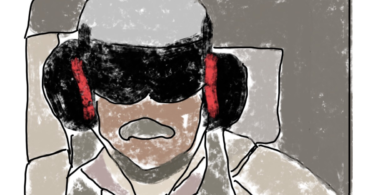Listen to this article:
Kyiv, UKRAINE – War can change so many things, even art.
On a recent visit with my friends to the Pinchuk Art Centre in Kyiv, I explored the exhibits of the museum’s current theme: how war can change artwork, and us.
I instantly felt how every corner of the place was soaked in an art vibe. The art center starts on the first floor of a five-story building. At the entrance, there was a stand with an audio guide. You could choose language – either Ukrainian or English.
At the first exhibit, I saw a lot of small human figures. They represented fallen soldiers – people who had given their lives for a free Ukraine.

I thought that one of them may have wanted to be an artist, someone else wanted to have a family, but we will never know that. The dreams of these soldiers will never come true.
Nearby, a TV was broadcasting news from Kharkiv during the war. As the audio guide explained, the artist wanted to keep the memory of his hometown, to which he will never return.
The next floor opened up new emotions for me.
The room emphasized communication and explanation, highlighting the importance of our sense of touch. Every object – visitors were allowed to touch the art – gave important information as the room contained articles from different regions of Ukraine.

Some of our cities will never again look like they did in the past. When you realize that, a shiver runs through your body.
At same time, in that room, I noticed a big TV with headphones. When you sit down and listen, you hear a short story about how war can change you as a person.
“If I could change my arms into wings, I would fly,” a voice says.
These philosophical ideas were so interesting. They can make you think a lot.

My favorite exhibit in the museum was about a hurricane. The main theme of this story is childhood, a time of innocence and discovery. A hurricane is something new for you when you are young. Some information can be dangerous and some can be strange for your young world.
Maybe I liked this room for its lightness of thought, when some things never delete from your memory. But after childhood you always grow up.

In the next room I noticed three paintings. Two were big, but in the middle hung one little painting.
My audio guide said that the larger canvas represents vulnerability and the small one is memory, untouchable.
The idea for these paintings is that during war, the artist cannot touch her partner, but in her memory, the feeling is amazing.
After that my friend found a new room with a uncomfortable exhibit.
Someone was whispering, but it was impossible to understand.
The idea was that your memories are getting worse every year. You would never see the occupied city again, in the same condition it was before the war. You would never retake exams, you wouldn’t remember how it was a few years ago.
Although you can feel nostalgia for a time or place, those moments are in the past.
Sometimes that is scary.
But when you can feel scared, at the same time you can find pain and cry from the heart.
And that’s what the main topic is, as shown by the following exhibits.
In the last room we visited, I saw red walls and many small but interesting figures. It was about holding in important emotions, definitely including inner anger.

The art we see can bring those emotions.
The exhibits at the Pinchuk Art Centre showed me depression, nostalgia and even hope.
In one of the rooms, the first thing I saw was a big TV. Around it was artificial flowers in a very beautiful composition. That TV told a story about a real place, but the people in it are like NPC characters who do not have limitations.

For me, that room offered a bit of hope, and was the most comfortable place. The main idea of this installation was that only your mind can create restrictions for you. If you wanna be free, you can!
Is it true that art can change you, even after just one visit? That magical arts can fill your mind with countless thoughts?
You can even start to think about topics that you never cared about before.

Ann Tsyhanok is a Junior Reporter with Youth Journalism International. You can listen to her read this in Ukrainian here.



